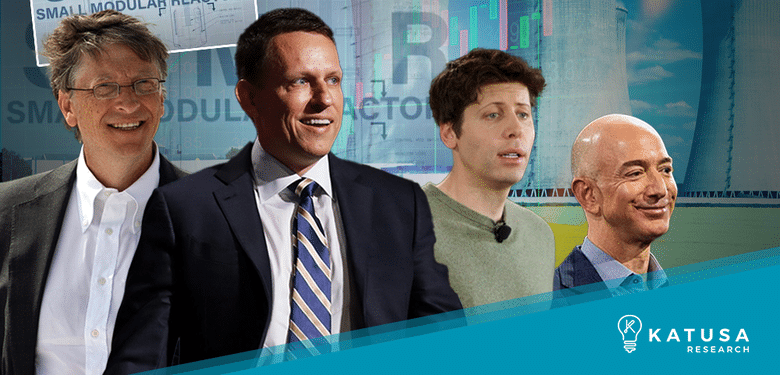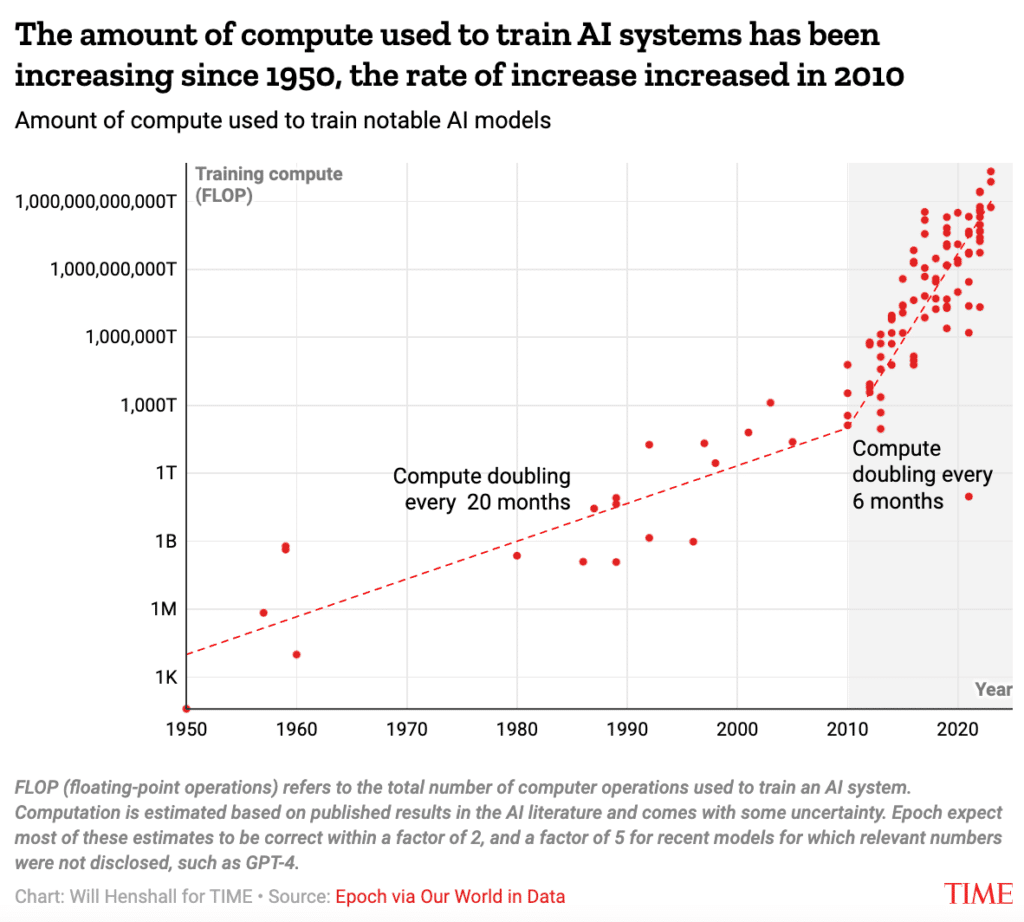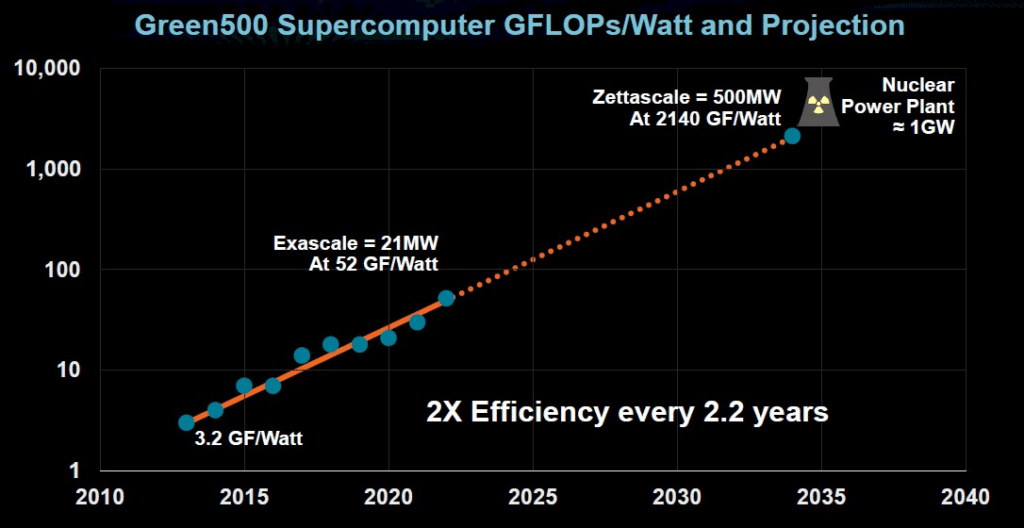
Dear Reader,Most people think that Bill Gates left his full-time role at Microsoft in 2008 to become a philanthropist.He did, but that’s not the full truth. That same year, he started a new company completely unrelated to computers.It was called Terrapower, and its lofty goal was to revolutionize nuclear energy in the U.S.Five years later, PayPal and Palantir cofounder Peter Thiel and OpenAI founder Sam Altman (The Godfather of ChatGPT) led a massive initial investment in another new nuclear company, Helion.That same year, Sam also funded and became the chairman of Oklo, which aimed to commercialize nuclear energy using small, mass-produced reactors.So why have three of the smartest, wealthiest, most successful men in Silicon Valley decided to branch out from computing and into nuclear—especially if nuclear is “dead”?What did they see coming a decade ago that the rest of us couldn’t?In a picture, this:

For half a century, the amount of computing power required to train AI systems doubled every twenty months—roughly following Moore’s Law.But in 2010, without explanation, that “law” broke.The amount of computing power used to train AI is now doubling every six months.In a little over a decade, the amount of computing power used to develop AI models has grown by a factor of 10 billion. And it shows no signs of slowing down.That’s why Sam Altman says AI is going to take “a lot, lot” of energy to keep developing.In short: AI is going to take far more energy than you can imagine. And that’s what Bill Gates and Peter Thiel also saw coming.
New Powerhouse on the Block
Note: You’ll want to re-read this section three times to see where we’re headed.To see how much energy we’re talking about, look at the world’s highest-capacity supercomputer, Frontier, which came online in 2022.It’s rated at 1.1 exaflops, which means it can perform 1 followed by 18 zero operations in a single second. That’s the kind of computing power now required to develop AI.Frontier is the most energy-efficient supercomputer on the planet. But it still requires 29 MW to run—or as much power as 30,000 homes.To put it another, Canada’s third-largest copper mine runs on 60 MW of power.And the development of the next biggest supercomputers is progressing at a breakneck pace:
- Intel’s Aurora supercomputer finished construction in June 2023. It’s twice as powerful as Frontier (and takes twice as much power).
- Meta expects to complete its AI Research SuperCluster later this year, which will be capable of 5 exaflops.
- And the Department of Energy requested bids for building a 20 exaflop supercomputer by 2025.
Intel has already launched its so-called “Zetta Initiative.” It plans to build a zettascale computer—1,000 times as powerful as the most powerful computer that exists today—by 2027.
There’s Just One Huge Problem…
If a single zettascale computer were built using today’s tech, it would require 21 nuclear power plants to run.For context, that’s as much energy as is used by all the data centers in the U.S. today… combined.
“Power is the number one challenge that we have to continue the dramatic increases in performance and capability that we have seen.” – AMD CEO Lisa Su
Fortunately, efficiency is improving alongside computing power. Even so, at the current rate of growth, a single supercomputer will still take half a nuclear power plant to run in 2034.

The goal is to get a zettascale computer down to 100MW of power consumption, which is roughly the output of a 21st-century small modular nuclear reactor.It’s also the power consumption of a major mine, oil refinery, and chemical refinery (I’m connecting the dots for you on cross-sector potential)That’s exactly what Oklo, Helion, TerraPower, and others are preparing to provide: small nuclear reactors, built specifically to power supercomputers so that AI can transform our world.And they won’t stop at just supercomputers. Super mines, super refineries, and super sites require loads of reliable clean baseload power.And they’re coming faster than you think.
A Chain Reaction with World-Changing Consequences
Because for Gates and Altman, Chat-GPT was only one part of a two-piece puzzle:
“The two most important inputs to a really great future are abundant intelligence and abundant energy.” – Sam Altman
And for the past decade, they’ve been quietly working hard on both.It’s just that developing new nuclear reactors is slightly harder than creating generative AI. But they’re finally ready to go mainstream.Take Sam Altman’s company, Oklo, for example.Oklo’s first reactor is scheduled to be approved next year—and to be generating electricity by 2027. The specs are revolutionary for nuclear:
- Expected cost of $60M per plant
- A construction time of less than one year
- Land footprint of under two acres
- “Walkaway safe” plant technology
Oklo already has nearly fifty more nuclear plants in the pipeline—half as many as the U.S. has built in the last century.It’s coming just in time since Open AI (in which Microsoft has invested billions) desperately needs cheap power. Sam Altman himself has publicly stated that “the compute costs [of Chat-GPT] are eye-watering.”And Microsoft needs more power than it can possibly get. In fact, Microsoft has said it could need more than 30 nuclear reactors just for its data centers.Once the smaller reactors have been proven for industry and defense purposes, they’ll be built out at a mass scale to power small towns.Fortunately, Sam Altman and Bill Gates are not in this alone. A dozen other visionary tech billionaires, including Jeff Bezos, Jack Ma, and Reid Hoffman, have all made huge bets on nuclear.The first small nuclear plant from Jeff Bezos’s company, General Fusion, is expected to begin generating power in 2025.Imagine what will happen when small nuclear reactors are manufactured at Amazon’s scale—first to power their data centers and AI, then to power your home as part of your Prime subscription. PAAS: Power as a Service!As quickly as Chat-GPT spreads through the world, AI will enable safe, cheap, nuclear energy.Only one tiny thing is standing in its way.
The Atom That Makes A.I. Possible
While advances in nuclear technology, necessitated by AI, will bring massive numbers of nuclear plants online…Uranium producers have deliberately taken massive amounts of uranium offline.Which means that the limiting factor now for both AI and nuclear is a single atom: uranium.Without uranium, nuclear reactors do not run and AI does not get developed.Gates’s TerraPower found that out the hard way when the war in Russia broke out. Russia is one of the only providers of the type of uranium TerraPower planned on using.So just as the company got a $750 million cash injection to build a reactor, it found that it would be incapable of buying any fuel for it.Which is why Bill Gates is already calling for a U.S.-based uranium supply. And that’s why part of Oklo’s stated mission is to “revitalize domestic nuclear fuel manufacturing.”It won’t just be a couple of nuclear startups bringing uranium production home.Because at the same time as nuclear is going mainstream in the U.S., dozens of other countries are restarting their own nuclear programs. That makes uranium independence a matter of national security.So the United States will take every step necessary to secure a domestic supply of uranium.In fact, on February 2, 2023 Senator Joe Manchin introduced Bill S.452…And if passed in the Senate, would require the Secretary of Energy to establish a Nuclear Fuel Security Program.Expect this Bill to pass the Senate in late November 2023.When the richest, smartest minds in the world—and the U.S. government—begin quietly moving in a new direction, it often pays to move with them.There’s something big brewing that we’re working on releasing to you…More on that in the coming days.Regards,Marin Katusa and the Special Situations Team
Details and Disclosures
Investing can have large potential rewards, but it can also have large potential risks. You must be aware of the risks and be willing to accept them in order to invest in financial instruments, including stocks, options, and futures. Katusa Research makes every best effort in adhering to publishing exemptions and securities laws. By reading this, you agree to all of the following: You understand this to be an expression of opinions and NOT professional advice. You are solely responsible for the use of any content and hold Katusa Research, and all partners, members, and affiliates harmless in any event or claim. If you purchase anything through a link in this email, you should assume that we have an affiliate relationship with the company providing the product or service that you purchase, and that we will be paid in some way. We recommend that you do your own independent research before purchasing anything.






